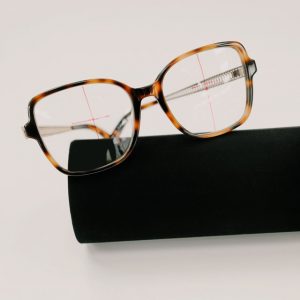Shopping for eyeglass frames can be quite overwhelming… but also lots of fun!
Eyeglasses nowadays come in a variety of styles, shapes, colors, and materials— metal, plastic, and even natural wood. Optical stores are filled with rows and rows of frames, manufactured by popular brands and designers to suit every taste and unique fashion sense.
While style is an important consideration, comfort and durability are also important factors that will directly affect the way you feel while wearing your new eyeglasses.
Which type of frame is right for you?
Eyeglass frames are manufactured using different types of materials— some frames are made of purely one type of material such as metal or plastic, while others contain a combination of materials, such as plastic frames with titanium temples.
Metal versus plastic
Nowadays, metal and plastic frames are made similarly in regards to their durability, weight, and cost. However, the metal composition can vary between frames— so it is important to consult with your eye doctor or optical dispenser before deciding on the winning pair. Also, if you are allergic to nickel, or another type of metal, be sure to look for frames that contain hypoallergenic materials.
Here is a guide to the different types of frames now available on the market.
Metal frames
Metal frames are known for their strength and durability, though each metal offers a unique advantage:
- Titanium frames are sturdy and strong, lightweight and corrosion-resistant. They are also hypoallergenic— an ideal choice for those with allergies to certain metals such as nickel.
- Beryllium frames are lightweight and strong, and are less expensive than titanium. These frames are also flexible and highly resistant to corrosion.
- Stainless steel frames are strong, lightweight— though a bit heavier than titanium, and corrosion resistant. They also tend to be less expensive than many other metal frames.
- Monel frames are made from a combination of metals— while nickel or other metals may cause an allergic reaction to sensitive skin, these frames contain a special coating to protect the skin from an allergic reaction. Monel frames are both flexible and corrosion-resistant.
- Aluminum frames are flexible, strong, and corrosion resistant. They tend to be more expensive than other metal frames.
- Flexon frames are very flexible— hence their name. These frames return to their original shape after being bent or twisted. Flexon frames are lightweight, hypoallergenic, and corrosion-resistant.
Contact an eye doctor near you to help you decide which frames will best fit you.
SEE RELATED: Should I Buy Glasses Online?
Plastic frames
Plastic frames are fashionable, lightweight and come in a variety of styles and colors. They are also typically less expensive than metal frames. Keep in mind though that plastic frames are not as strong as metal and tend to break more easily.
Plastic frames are made with different types of plastic:
- Zyl frames, also called zylonite, are lightweight, inexpensive, and easier to adjust and fit to your face. They are available in many different colors.
- Optyl frames are a type of epoxy resin. These frames are heated with a special machine in order to mold the plastic for an easier adjustment to your face.
- Cellulose acetate propionate frames are lightweight, containing a nylon-based hypoallergenic plastic. These frames are a bit softer than other plastic frames.
- Blended nylon frames are both lightweight and strong. These frames are well known for their wraparound styles— ideal for playing sports.
If you think plastic frames are for you contact an eye doctor to make sure they are a good fit.
Wooden frames
Wooden frames are quite unique and offer many advantages.
Wooden frames are made of natural wood, and are available in many different stains. They are also hypoallergenic, as they are made of pure wood, and coated with plant based and natural wood treatments. These frames are super lightweight and comfortable— not to mention stylish. Additionally, wooden frames require little processing and energy to produce, making them an eco-friendly choice.
Rimless frames
Rimless frames are also quite popular, especially among those who favor a more subtle look. They are available in a large variety of shapes and sizes— with half rimless frames an option as well.
These frames are lightweight, comfortable, and take the emphasis off the frame itself, as they are nearly invisible. Keep in mind that these frames are more delicate than rimmed frames, and more prone to breaking.
Other important factors to consider
Now that you have chosen the type of frame you are interested in, let’s look at the different aspects of the frame to help you narrow down your choice.
Frame size
Eyeglass frames are available in a large variety of sizes— finding a size that suits you should not be too difficult. While you may favor smaller frames for reading glasses, if you will be wearing your eyeglasses all day, a larger frame will provide a larger viewing window and increased peripheral vision.
However, keep in mind that your optical prescription will determine the thickness of the lens. If you have a strong prescription, it is typically recommended to avoid large frames— the larger the frame, the thicker the lens— although this can be minimized with hi-index lenses.
Bridge fit
The bridge fit is an important aspect that shouldn’t be overlooked. Eyeglasses need to fit on the bridge of your nose so they don’t move or slide down when you bend over or turn your head from side to side. Make sure that the bridge fit is not too small or that it doesn’t sit too high, otherwise it will pinch your nose.
Temple style
The temples connect the front of the eyeglasses to the back of your head, behind your ears. Some temples, called comfort cable temples, wrap around the back of the ears, while other temples are designed without a curve, and put slight pressure on the sides of the head to prevent them from slipping or falling.
For your eyeglasses to fit comfortably without sliding down, the temples must be the correct length for your head size— most frames contain temples that range in length from 120 to 150 mm. If you are not sure if the frame’s temples fit correctly, ask your optical dispenser for help.
Spring hinges
Spring hinges allow the temples to flex outward, without causing any damage— ideal for those who tend to be rough on their glasses or fall asleep with their glasses on. Purchasing frames with spring hinges will decrease the probability that you will need to visit the optical store on a regular basis to adjust or repair your frames.
To ensure that you walk out of the store with the most appropriate frames for you, take your time to look through all of the choices, and use this guide to help direct you in your decision.
LEARN MORE: Optical and Contact Lenses
If you are still uncertain about which eyeglass frames are right for you, ask an eye doctor or optician— they can help you to determine the best fit and most appropriate shape and size to guarantee that you are truly happy with your new frames.

